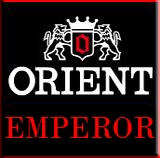|
|
|
MASERATI BITURBO SPYDER(o spider)
1:18 MINICHAMPS (code 107123531)
Year/Anno : 1986
Color : Black/Nero interni beige
My rating/Mio Voto : 87/100
Value for Money/Rapporto qualità prezzo : 78/100
Original price/Prezzo : €uro 160 (2016) al momento in promozione in alcuni negozi
Materiale: Resin/Resina
Clicca il banner in alto per tornare alla Homepage e visionare altri modelli.
Click on the banner on the top of this page to return at the Homepage and see all the other models of my collection.
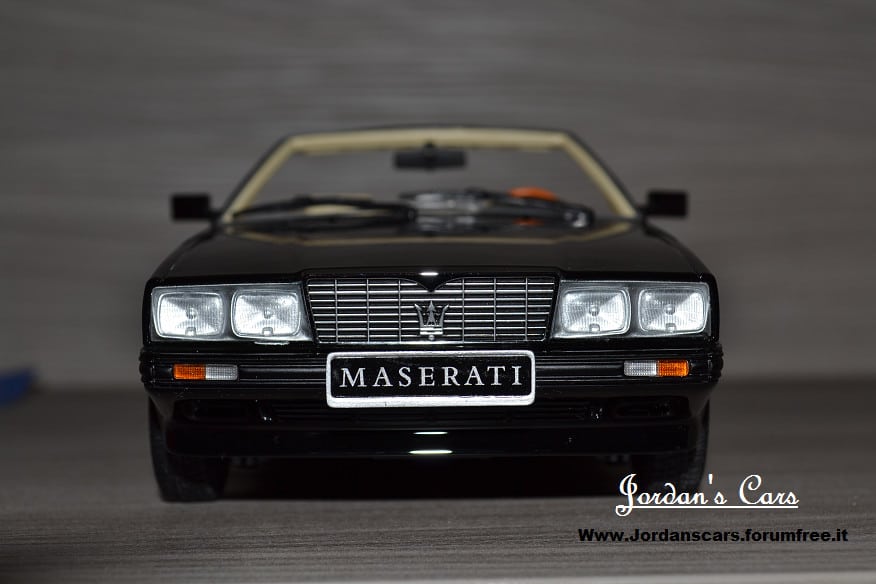
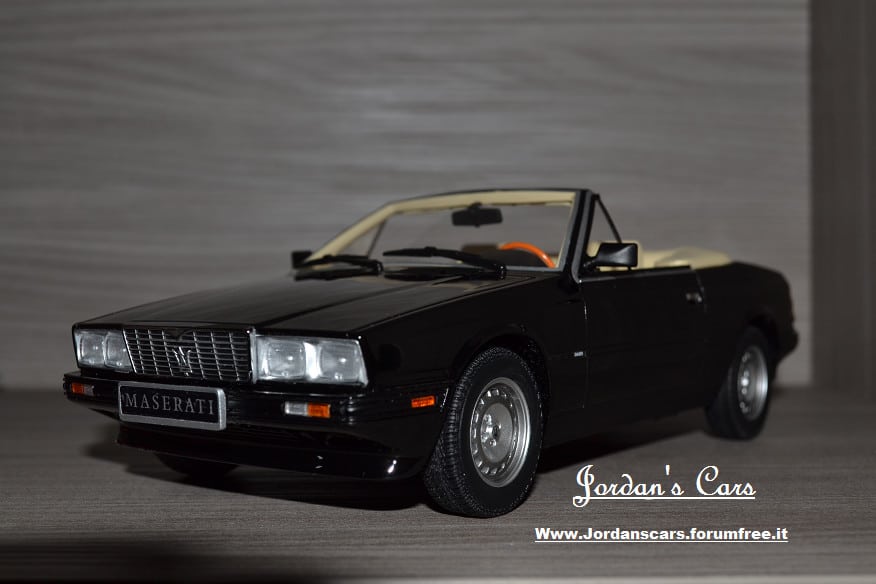
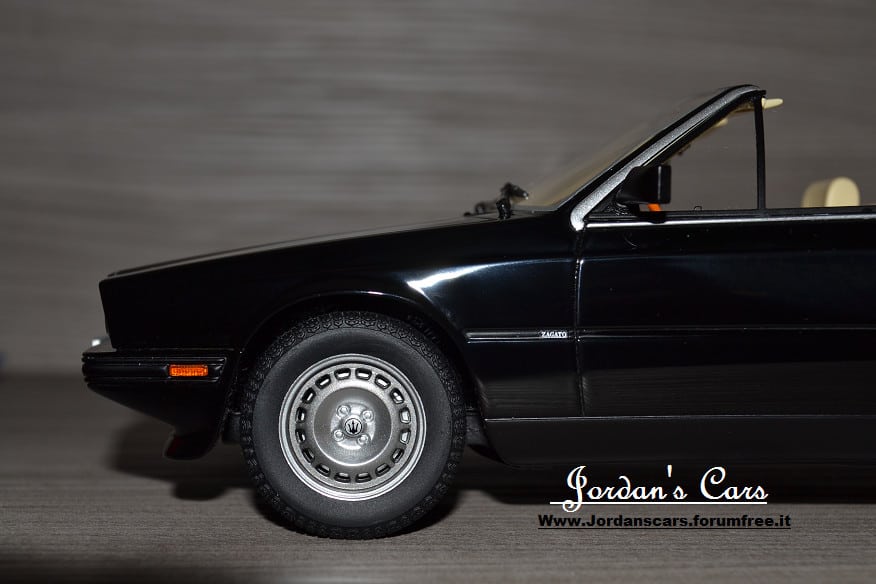

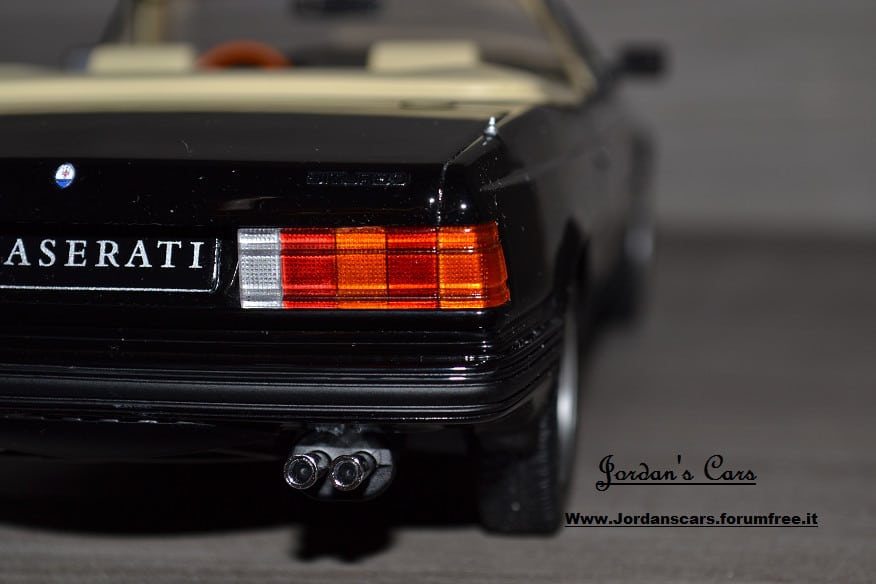
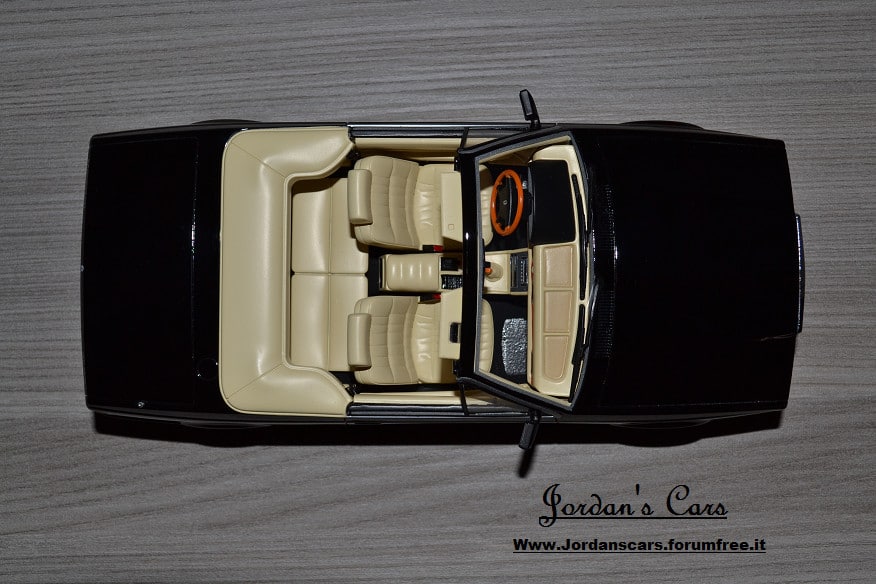
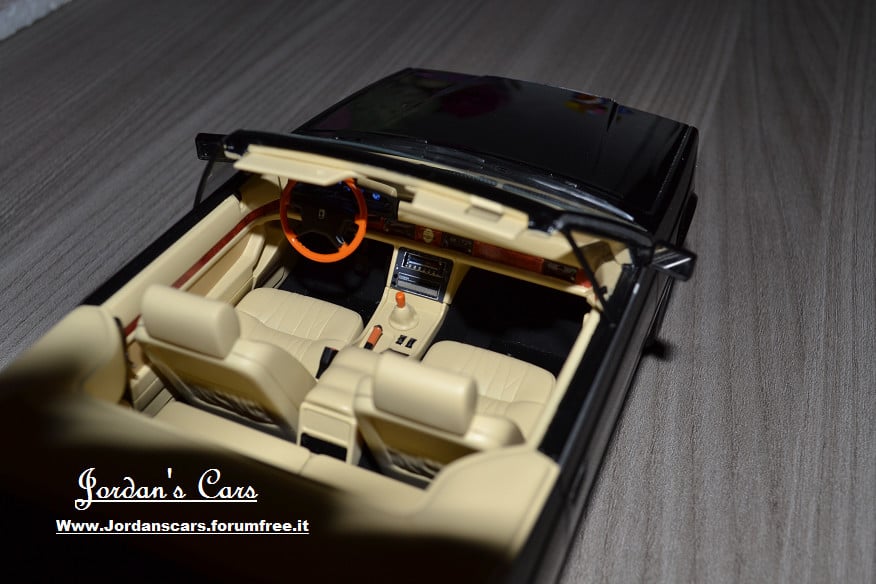
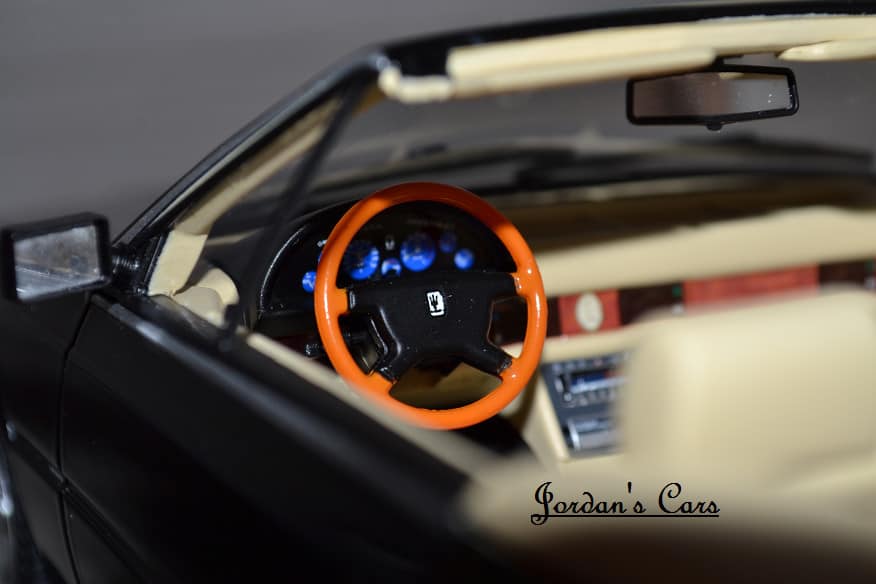
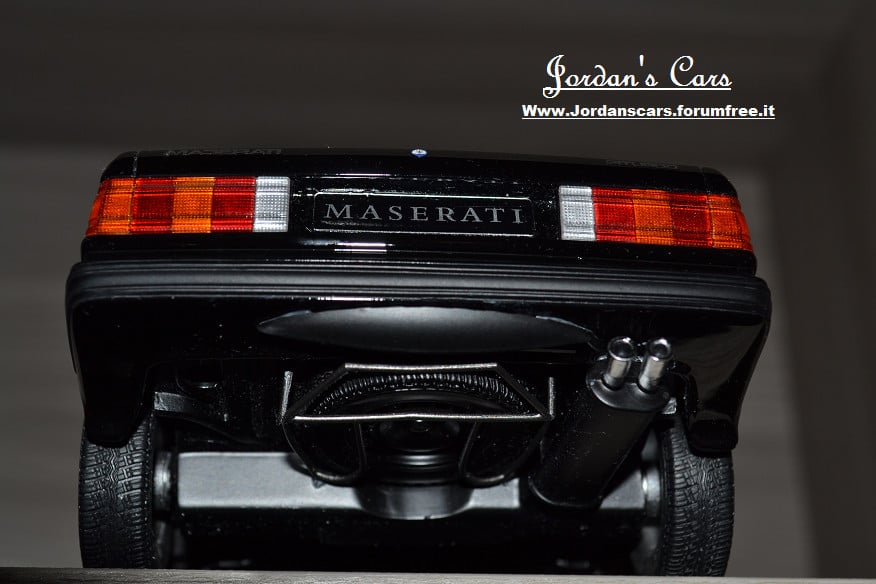
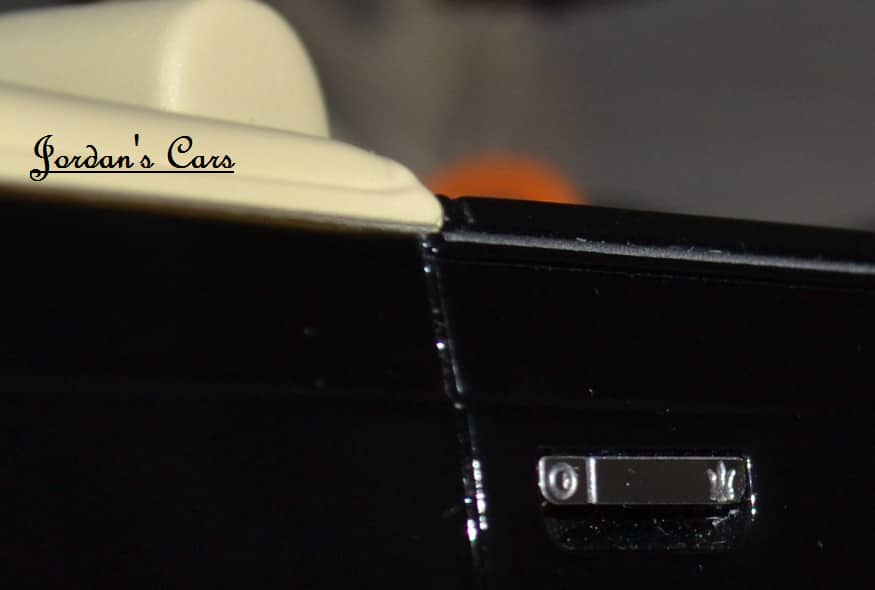
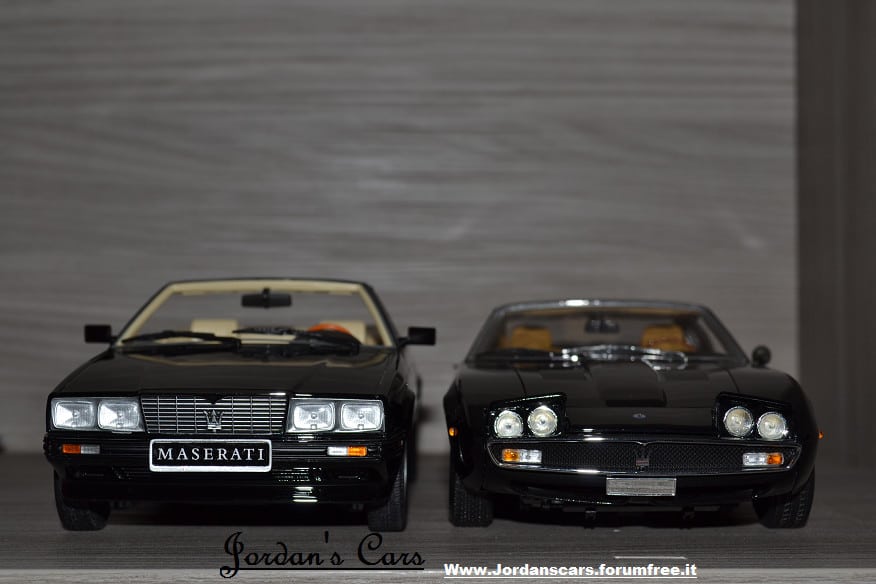

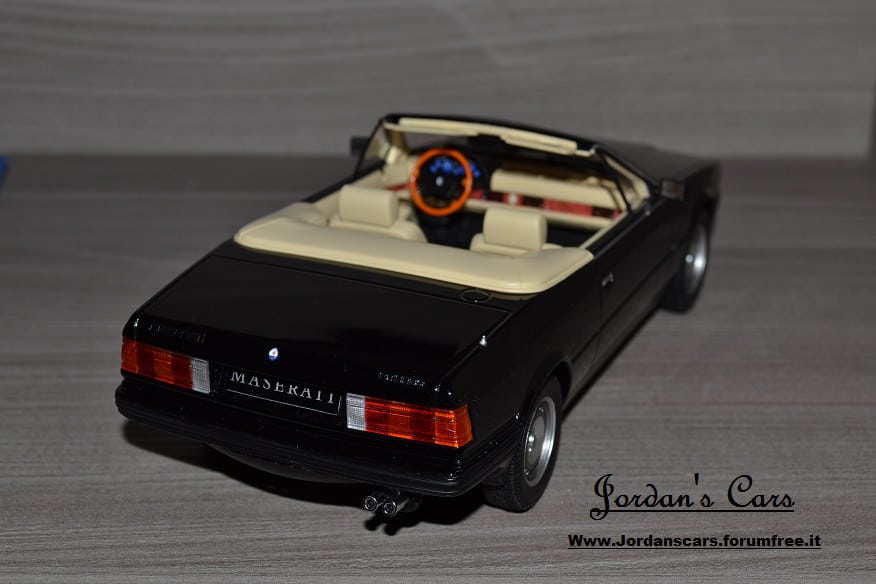
Storia(From Wiki):
La Maserati Biturbo è un'autovettura prodotta dalla Maserati tra il 1982 ed il 1996.
Voluta da Alejandro De Tomaso, che aveva acquisito la proprietà della Casa del Tridente nel 1976 dalla Citroën, la Biturbo doveva essere il modello dei grandi numeri: grazie al prezzo competitivo (poco più di 22 milioni di Lire al lancio) era prevista una produzione di almeno 5 000 esemplari all'anno. L'obiettivo non fu mai raggiunto anche a causa dei problemi di affidabilità generati dall'incompleto sviluppo della vettura per accelerarne i tempi di commercializzazione. In Nordamerica, ci furono casi di Biturbo che presero fuoco (gli anelli di gomma sintetica che sostenevano il sistema di scarico, surriscaldandosi iniziavano ad emettere fumo e bruciare) ed una spericolata politica commerciale (poche settimane dopo il lancio il prezzo fu portato di colpo a oltre 26 milioni di Lire), raffreddarono le vendite. Oltre tutto le vistose finiture interne non erano, almeno inizialmente, sempre di qualità eccelsa.
Caratterizzata da una classica ed elegante linea coupé a 3 volumi (la cui paternità è della progettazione interna di Pierangelo Andreani, Capo Stile Maserati, per quanto influenzata da Giugiaro, disegnatore della Quattroporte del 1979 a cui la Biturbo si ispira[1]) da una impostazione tecnica classica (motore anteriore longitudinale, trazione posteriore, sospensioni anteriori a ruote indipendenti, retrotreno a bracci oscillanti e impianto frenante con dischi davanti e dietro), la "Biturbo" venne lanciata nel 1982.
Il motore, un V6 bialbero alimentato a carburatori derivava da quello della Merak, da cui differiva per il numero di valvole (3 per cilindro anziché 2) e per il sistema di sovralimentazione composto da 2 turbocompressori (uno per bancata). La cilindrata era di 2491 cm³ per i mercati esteri e 1996 cm³ per l'Italia (ove vigeva un regime di Iva al 38% estremamente penalizzante per le cilindrate oltre i due litri), ma la potenza rimaneva abbastanza simile: 192CV per le 2500 e 180 CV per le 2000.
Per far fronte alla produzione prevista (35 esemplari al giorno) solo motore e sospensioni venivano assemblate alla Maserati di Modena; il resto della vettura era prodotta alla Innocenti di Milano Lambrate. Nel 1984 venne presentata la Biturbo S di cui vennero costruiti 1.038 esemplari sino al 1986[2], con motore 2 litri potenziato (grazie all'adozione di un intercooler che permetteva di aumentare la pressione dei turbocompressori) a 205 CV, 4 freni a disco, interni con diverse finiture (tessuto Missoni per i sedili, diversa strumentazione) e livrea più sportiva (mascherina a nido d'ape nera, cornici dei vetri brunite, cerchi fucinati, prese d'aria sul cofano motore, alettone posteriore, paraurti e fascioni laterali neri con minigonne, inoltre sempre nello stesso anno fu introdotto su tutte le versioni un sistema di gestione delle turbine denominato M.A.B.C. acronimo di Maserati Automatic Boost Control, che servì a limitare gli eccessi di pressione nelle turbine.
Nel 1985 vennero presentate anche le Biturbo 425 e le Biturbo Spyder. La prima era la variante berlina a 4 porte basata sul pianale della coupé allungato, mentre la seconda una spyder 2 porte basata sul pianale accorciato. Entrambe erano mosse da V6 biturbo di 2,5 litri da 192 CV. Pochi mesi dopo vennero rese disponibili, solo per l'Italia, le Biturbo 420 e Biturbo Spyder 2.0, mosse dal V6 con cilindrata ridotta a 1996 cm³ e potenza di 180 CV. Nel 1986 venne introdotta anche la Biturbo 420 S (con varianti estetiche simili alla coupé S) e motore da 205 CV. Furono prodotti solo 2810 esemplari della 420 e 254 della 420S prima dell'introduzione delle nuove motorizzazioni.
Nel 1987 tutti i motori adottarono l'alimentazione a iniezione elettronica Multipoint, ottenendo una maggior regolarità di funzionamento nonché un leggero incremento di potenza, perdendo tuttavia la rabbiosità nell'erogazione tipica dei motori a carburatore: 187 CV per le Biturbo 2.0i (coupé e Spider)[3] e Biturbo 420i, 220 CV per le Biturbo 2.0 Si che adottarono anche dei cerchi più larghi sempre dello stesso diametro (7jx14) e Biturbo 420 Si e 196 CV per le Biturbo 2.5i (coupé e Spider) e Biturbo 425i. Nel 1988 un restyling rivoluzionò la gamma. Tutte le versioni adottarono un frontale più morbido, nuovi paraurti, diversi cerchi, nuovi interni (con modifiche a plancia, sedili, pannelli porta) e finiture notevolmente migliorate. Rivisti o inediti i motori: alla base si poneva il V6 biturbo di 1996 cm³ tre valvole per cilindro a iniezione da 223 CV, che muoveva le Biturbo 222 (coupé), Biturbo 422 (berline) e le Spider 2.0i. Lo step superiore era rappresentato dalla versione a 4 valvole per cilindro del V6 2 litri (245 CV), che spingeva le Biturbo 2.24V e Biturbo 4.24V (caratterizzate come le precedenti S, di cui prendevano il posto nella gamma). Al vertice un nuovo V6 quattro valvole di 2790 cm³ da 250 CV, riservato alle 430i, "228" e Spider 2.8i. Le uniche Biturbo dotate di ABS erano la berlina 4.18v prodotta in 77 esemplari dal 1991 al 1992 (in pratica una 422 con frontale e posteriore della 4.24v ma con un solo doppio scarico a destra.) e le ultime 430 (sia 18 che 24v).
Nel 1989 la Maserati passò da De Tomaso alla Fiat.
Nel 1991 la gamma delle coupé 2 porte s'ampliò con l'introduzione della Racing, estrema evoluzione dell'originaria Biturbo, prodotta in serie limitata di soli 230 esemplari. La nuova sportiva era spinta da una versione evoluta del V6 24 valvole, portato a 285 CV di potenza. La Racing anticipò nelle linee la Biturbo 224 restyling, in quanto quest'ultima adottava il frontale modificato con mascherina più bassa e fari poliellissoidali, i nuovi cerchi a razze (poi adottati anche dalla Shamal e dalla prima serie della Ghibli II) e, in alcuni casi, la fanaleria posteriore brunita, montata esclusivamente sulle Racing di colore nero. Due erano i colori disponibili: Rosso e, appunto, Nero, con interni Neri o Ghiaccio privi delle guarnizioni in radica prerogativa della serie Biturbo e sostituiti da modanature in carbonio.
La Biturbo venne sostituita dalla Maserati Ghibli nel 1992, quest'ultima non era altro che una profonda evoluzione basata sulla stessa Biturbo con numerosi componenti ereditati della Racing.
_________________________________________________________________
The Maserati Biturbo was a family of luxury sports cars, saloons and grand tourers produced by Maserati between 1981 and 1994. The original Biturbo was a two-door, four-seater notchback coupé (of somewhat smaller dimensions than the BMW 3 Series of the time) featuring, as the name implies, a two-litre V6 engine with two turbochargers and a luxurious interior. The car was designed by Pierangelo Andreani, Chief of Centro Stile Maserati up to 1981, somewhat influenced by the design of the recent Quattroporte III (Italdesign Giugiaro).
All Maserati models introduced from the Biturbo's inception in 1981 until 1997 were based on the original Biturbo architecture. Among them the coupés as the 2.24v. and the Racing, saloons as the 420, 425 and 430, the convertible Spyder, the Karif, the 228, the later grand tourers like Shamal and Ghibli II, as well as the Maserati Barchetta which used an ultimate version of the biturbo V6 engine.
When Alejandro de Tomaso acquired Maserati in 1976, he had ambitious plans for the marque. His plan was to combine the prestige of the Maserati brand with a sports car that would be more affordable than the earlier high-priced models that had traditionally made up the Maserati range. In fact, Maserati ceased making supercars like the ones developed under Citroën ownership altogether, like the Bora and Khamsin.
The Biturbo was initially a strong seller and brought Italian prestige to a wide audience, with sales of about 40,000 units. Sales figures fell in subsequent years. De Tomaso also used another of his companies, Innocenti, to produce Biturbo body panels and also to provide final assembly of Biturbos.[1] De Tomaso later sold Maserati to Fiat, who grouped the company with their erstwhile rival Ferrari.
The Biturbo is number 28 in the BBC book of "Crap Cars" and in 2007 was selected as Time Magazine's worst car of 1984, although they ranked the Chrysler TC by Maserati as a "greater ignominy".
The Biturbo competed unsuccessfully in the British Touring Car Championship in the late 1980s, the European Touring Car Championship and the World Touring Car Championship (1987).
Between 1987–89 a facelift was phased in, which helped to soften the sharp bodylines. The redesign included a taller and more rounded grille with mesh grille and bonnet, aerodynamic wing mirrors and 15" disc-shaped alloy wheels, now mounted on 5-lug hubs. Some models received the wraparound bumpers with integral foglights and the deep sills introduced with the 2.24v
In 1991 the entire lineup was restyled for a second time, again by the hand of Marcello Gandini; the design features introduced with the Shamal were spread to the other models. Gandini, the Shamal's designer, developed an aerodynamic kit that included a unique spoiler at the base of the windscreen hiding the windshield wipers, a rear spoiler, and side skirts. The new two-element headlights used poliellypsoidal projectors developed by Magneti-Marelli. Inset in body-colour housings, they flanked a redesigned grille, slimmer and integrated in the bonnet; the 1988 bumpers were adopted by all models. The 15" disc-shaped alloys were replaced by new 16" seven-spoke wheels, with a hubcap designed to look like a centerlock nut. The second facelift was referred to as nuovolook.
The convertible Biturbo was designed and assembled by Zagato in Milan. It was Zagato's first work for Maserati since the A6G/2000 of thirty years earlier. Embo of Caramagna was first commissioned to develop a four-seater cabriolet version of the Biturbo, which was shown at the April 1982 Turin Auto Show, but their proposal never made it to production.
The Spyder was built on a 2.4 metres (7.9 ft) wheelbase, some 11.4 cm (4 in) shorter than the coupé's. Still, since it is a strict two-seater with folding rear seats, the luggage space is larger than in the original Biturbo. It was on this short chassis that the sporty hardtop Karif was later developed. Overall 3,076 were built over a ten-year period, setting a production record for Maserati Spyders.
The first Spyder was launched at the Turin Motor Show in 1984. It was offered both with the two litre and two-and-a-half litre "export" engine. Two years later fuel injection arrived on the Spyder i. 297 were made in 2.0 L and 122 in 2.5 L form.
In 1989 the Spyder was facelifted as model year 1990, known as Spyder i 1990 (or '90). The car received the full 1988 Gandini treatment, one year after the other models: rounded grille, fuller bumpers, aerodynamic wing mirrors and 15" wheels on five-lug hubs. As on the rest of the Biturbos the export engine grew to displace 2.8 L. A four-speed automatic transmission was available on request.
The third series, or Spyder III, was introduced in 1991 in occasion of Gandini's second facelift that renewed the entire range. This included the new bonnet and grille, ellypsoidal headlights in body-colour housings, a spoiler at the base of the windscreen, deeper body-colour sills and 16" seven-spoke wheels. Spyder IIIs were fitted with Maserati's Ranger limited slip differential Whereas the 2.0 L third series Spyder received 24-valve engines, 2.8 L cars still used 18-valves, thus remaineing the only 2.8 L Biturbo model to never get a 4-valve head upgrade.
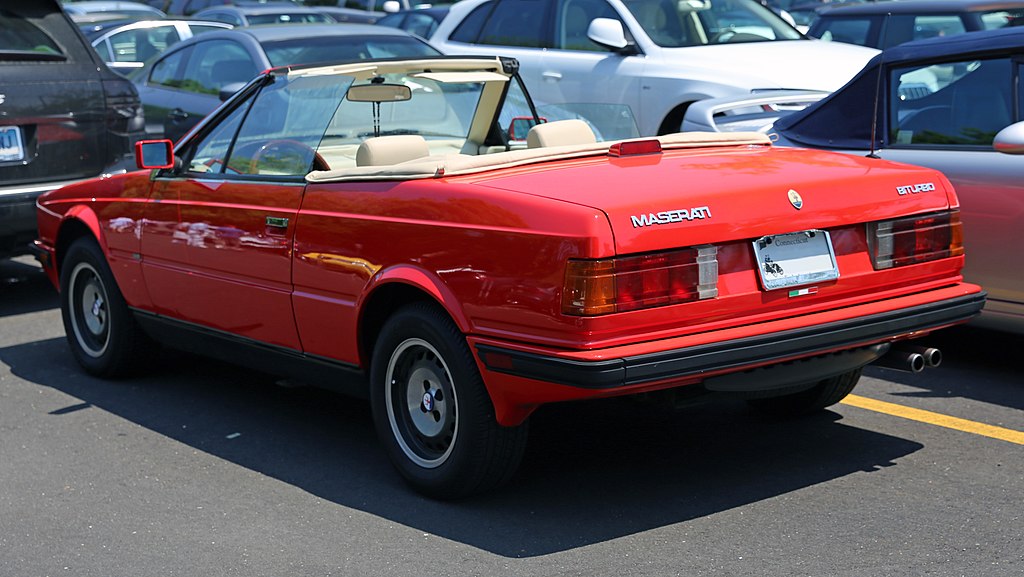
Modelli correlati/ Related model cars:
MASERATI GRANCABRIO MC STRADALE---> https://jordanscars.forumfree.it/?t=72454625
Edited by xJORDANx - 12/11/2016, 13:01
|
|




















